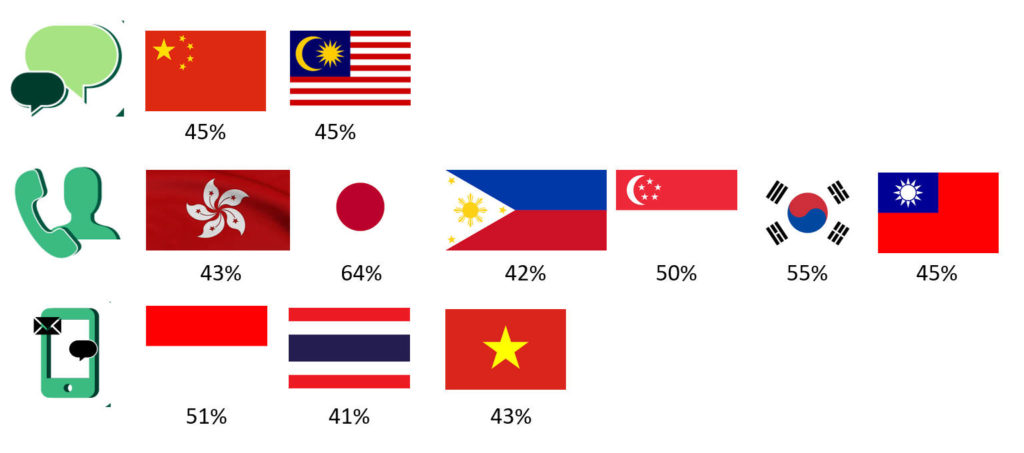Commissioned by Infobip, the Forrester Consulting study ‘Redefining Human and Automated Engagement – How APAC Consumers Have Impacted the CX Agenda’, revealed that customers in Hong Kong and 10 other Asian markets, expect real-time personalised services and interactions enabled by digital and automated engagement mechanisms.
Organisations should therefore holistically weave human-assisted and automated service capabilities into customer journeys to achieve efficiency and loyalty.

Source: Forrester/Infobip 2022
Human touchpoints complement automation
The study found that customer preferences for automated chatbots in purchase journeys have risen from 24% to 26% since 2019, indicating that there is an opportunity for organisations to invest in automation and scale convenience, providing the autonomy that customers seek.
However, consumers remain reliant on live support, and human interaction is still a necessary aspect of CX to achieve customer satisfaction.
In Hong Kong, the study found that the top three preferred customer service touchpoints are: human agent over the phone (43%); online live chat (35%); and social media (31%). This emphasises that human touchpoints remain relevant in the market alongside automated and digital services.
Understanding is key to elevating CX
According to the study, 38% of Hong Kong respondents expressed that their last customer experience did not leave them with positive emotions, as some brands faced challenges in providing an easy experience in the customer journey. As a result, Hong Kong brands received a CX score of 3.7 which is lower than the APAC average of 3.9. One of the key considerations in delivering a pleasant and efficient servicing experience is embedding hybrid elements in the process, based on the engagement preferences of their customers.
To balance human touchpoints and automation for CX, Hong Kong organisations should distinguish between the unique needs of customer personas to enable positive CX and keep up with their APAC counterparts. The paper identified 4 distinct personas that emerged in the digital era based on their age, income, and engagement preferences.
Research showed that 46% of Hong Kongers are affluent hybrid shoppers who are comfortable with cross-channel interactions across human-assisted and digital touchpoints; 21% are reserved high-touch seekers that prefer human-assisted touchpoints; 20% are low-touch digital natives that prefer digital touch points; and 12% are neutrals that prefer to keep all communications within a single touchpoint, regardless of it being human-assisted or digital.
“As Hong Kong businesses increasingly realise the importance of hybrid CX, we are seeing a significant uptick in the number of organisations that are planning to upgrade their CX strategies to generate tangible business value,” said Tina Wang, regional manager of Infobip APAC.
She added that with elevated CX, customer loyalty can be heightened, leading to increased advocacy, retention, and revenue for businesses and brands, which are crucial to thriving in such a competitive market.
“With affluent hybrid shoppers making up most consumer personas, Hong Kong businesses must quickly refine their CX to provide cross-channel interaction based on consumer preferences, where automation and human support can complement each other optimally,” continued Wang.
She suggested that businesses should look to reconcile the CX ecosystem by working with an experienced partner that can leverage cloud communications technology to help them strengthen collaboration, streamline operations, and improve omnichannel interactions across all stages of the customer journey.
Different customer preferences
Divergent trends were also evident across vertical industries. In general, reserved high-touch seekers are related to the banking, financial services, and insurance sector, where consumers prioritize access to relationship managers.
In comparison, low-touch digital natives exhibited greater affinity with the retail industry where the shift to e-commerce and increased utilization of cloud services have equipped retailers to better service customers through enhanced digital business models.
In terms of the top verticals ranked by CX scores (at a scale of 1 - 5), retail (4.1) ranked first, followed by food and beverage (4.0), content streaming providers (4.0), energy and utilities (4.0) and technology (4.0), indicating the significance for the local retailers to keep up the pace in improving CX to win customer loyalty.
Adopting hybrid CX
Organisations are failing to address consumer demands for human agents as part of a hybrid CX; among respondents who said that their recent customer service interactions failed to meet expectations, 60% felt that it was not easy to connect with a human agent.
To boost hybrid CX, organisations will not only need to tap into standalone or artificial intelligence capabilities but also increase investments in cloud-based technology to achieve seamless and effective omnichannel communications. This is key to synergizing capabilities of both machine and man to achieve CX excellence and improved customer satisfaction.





